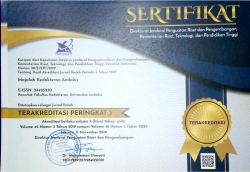ASUPAN GULA HARIAN DARI BAHAN-BAHAN PELENGKAP MASAKAN
Abstract
Keywords
Full Text:
PDFReferences
American Diabetes Association, Diagnosis and classification of diabetes mellitus. Diabetes care. 2014;37(suppl1):81-9.
Murad MA, Abdulmageed SS,Iftikhar R, Sagga B. Assessment of the common risk factors associated with type 2 diabetes mellitus in Jeddah. Int J Endocrinol. 2014:616145. doi: 10.1155/2014/616145.
Badan penelitian kesehatan kementrian kesehatan RI. Riset Kesehatan Dasar. Jakarta: Dinas Kesehatan Republik Indonesia; 2013.
Magliano DJ, Barr ELM, Zimmet PZ, Cameron AJ, Dunstan DW, Colagiuri S. Glucose indices, health behaviors, and incidence of diabetes in Australia. Diabetes Care. 2008;31(2):267–72.
Singh VP, Bali A, Singh N, Jaggi AS. Advanced glycation end products and diabetic complications. Korean J Physiol Pharmacol. 2014;18(1):1-14.
Gregg EW, Li YF, Wang J, Burrows NR, Ali MK, Rolka D, et al. Changes in diabetes related complications in the United States, 1990-2010. NEJM. 2014;370(16):1514-23.
Vijayaraghavan K. Treatment of dyslipidemia in patients with type 2 diabetes. Lipids Health Dis. 2010;9:144.
Franz MJ, Bantle JP, Beeb CA, Brunzell JD, Chiasson JL, Garg A, et al.. Nutrition Principles and Recommendations in Diabetes. ADA. 2004;27(1):S36-S46.
Solano M, Golberg R. Lipid management in Type 1 diabetes. 2006;24(1):27–32.
Feinman RD, Pogozelski WK, Astrup A, Bernstein RK, Fine EJ, Westman EC, et al. Dietary carbohydrate restriction as the first approach in diabetes management: Critical review and evidence base. Nutrition. 2015; 31(1):1–13.
Badan Pengawas Obat dan Makanan. Mengenal Angka Kecukupan Gizi Bagi Bangsa Indonesia. InfoPOM. 2014;15(4):3-5.
Dietary carbohydrates : sugar and starches. In : Dietary reference intake. Washington. 2005;6:265-324.
Johnson RK, Appel LJ, Brands M, Howard BV, Lefevre M, Lustig RH, Sacks F, et al. Dietary sugars intake and cardiovascular health. Circulation. 2009;120(11):1011-20.
Basu S, Yoffe P, Hills N, Lustig RH. The relationship of sugar to population-level diabetes prevalence: an econometric analysis of repeated cross-sectional data. PLoS One. 2013;8(2):e57873.
Malik VS, Pan A, Willett WC, Hu FB. Sugar-sweetened beverages and weight gain in children and adults:a systematic review and meta-analysis. Am J Clin Nutr. 2013;98:1084-102.
Sonestedt E , Overby NC , Laaksonen DE, Birgisdottir BE. Does high sugar consumption exacerbate cardiometabolic risk factors and increase the risk of type 2 diabetes and cardiovascular disease? Food Nutr Res. 2012;56:19104.
Imamura F, O’Connor L, Ye Z, Mursu J, Hayashino Y, Bhupathiraju SN, Forouhi NG. Consumption of sugar sweetened beverages, artificially sweetened beverages, and fruit juice and incidence of type 2 diabetes: systematic review, meta-analysis, and estimation of population attributable fraction. BMJ. 2015;351:3576.
Nguyen NT, Nguyen XMT, Lane J, Wang P. Relationship between obesity and diabetes in a US adult population: Findings from the national health and nutrition examination survey, 1999–2006. Obes Surg. 2011;21(3):351–5.
Rippe JM, Angelopoulos TJ. Added sugar and risk factors for obesity, diabetes and heart disease. Int J Obesity. 2016; 40(1):S22-7.
Malik VS, Popkin BM, Bray GA, Despres JP, Willet WC, Hu FB. Sugar-sweetened beverages and risk of metabolic syndrome and type 2 diabetes. Diabetes Care. 2010;30(11):2477-83.
Rippe JM, Angelopoulos T. Sugar and health controversies : What does the science say. Adv Nutr.2015;6(Suppl):493S–503S.
Goran MI, Ulijaszek SJ, Ventura EE. High fructose corn syrup and diabetes prevalence. A global perspective. Glob. Public Health 2013;8:55-64.
Report of Dietary Guidelines Advisory Committee on the for Americans. US Department of Agriculture, Center for Nutrition Polic and Promotion, Washington, DC, USA; 2010.





















